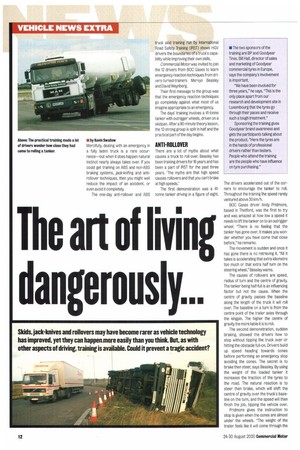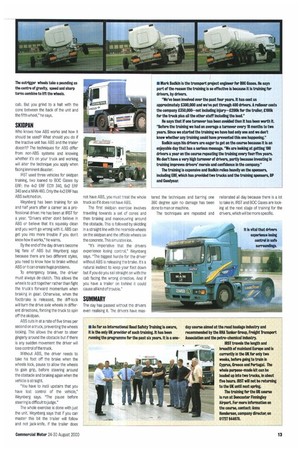The art of livin dangerously...
Page 14

Page 15

If you've noticed an error in this article please click here to report it so we can fix it.
• by Kevin Swallow
Mercifully dealing with an emergency in a fully laden truck is a rare occurrence—but when it does happen natural instinct nearly always takes over. If you could get training on ABS and non-ABS braking systems, jack-knifing and antirollover techniques, then you might well reduce the impact of an accident, or even avoid it completely.
The one-day anti-rollover and ABS truck skid training run by International Road Safety Training (IRST) shows HGV drivers the boundaries of a truck's capability while improving their own skills.
Commercial Motor was invited to join the 12 drivers from BOO Gases to learn emergency reaction techniques from drivers-turned-trainers Mervyn Beasley and David Weynberg.
Their first message to the group was that the emergency reaction techniques go completely against what most of us imagine appropriate to an emergency.
The days' training involves a 41-tonne tanker with outrigger wheels, driven on a skidpan. After a 90-minute theory lesson, the 12-strong group is split in half and the practical part of the day begins.
AEI-ROLLOVER
There are a lot of myths about what causes a truck to roll over. Beasley has been training drivers for 16 years and has been a part of IRST for the past three years. The myths are that high speed causes rollovers and that you can't brake at high speeds."
The first demonstration was a 41tonne tanker driving in a figure of eight. The drivers accelerated out of the corners to encourage the tanker to roll. Throughout the training the speed rarely ventured above 30 km/h.
BOO Gases driver Andy Pridmore, based in Thetford, was the first to try and was amazed at how low a speed it needs to lift the tanker on to an outrigger wheel. 'There is no feeling that the tanker has gone over. It makes you wonder whether you have come that close before," he remarks.
The movement is sudden and once it has gone there is no retrieving it. "All it takes is accelerating that extra kilometre too much or that extra half turn on the steering wheel," Beasley warns.
The causes of rollovers are speed, radius of turn and the centre of gravity. The tanker being half-full is an influencing factor but not the cause. When the centre of gravity passes the baseline along the length of the truck it will roll over. The baseline on a turn is from the centre point of the trailer axles through the kingpin. The higher the centre of gravity the more liable it is to roll.
The second demonstration, sudden braking, showed the drivers how to stop without tipping the truck over or hitting the obstacle full-on. Drivers build up speed heading towards cones before performing an emergency stop avoiding the cones. The secret is to brake then steer, says Beasley. By using the weight of the loaded tanker it increases the traction of the tyres to the road. The natural reaction is to steer then brake, which will shift the centre of gravity over the truck's baseline on the turn, and the speed will then finish the job, tipping the vehicle over.
Pridmore gives the instruction to stop is given when the cones are almost under the wheels. "The weight of the trailer feels like it will come through the cab. But you grind to a halt with the cone between the back of the unit and the fifth wheel," he says.
SKIDPAN
Who knows how ABS works and how it should be used? What should you do if the tractive unit has ABS and the trailer doesn't? The techniques for ABS differ from non-ABS systems and knowing whether its on your truck and working will alter the technique you apply when facing imminent disaster.
IRST used three vehicles for skidpan training, two loaned to BOO Gases by ERF: the 4x2 ERF E011 340, 6x2 ERF 340 and a MAN 460. Only the 4x2 ERF has ABS switched on.
Weynberg has been training for six and half years after a career as a professional driver. He has been at IRST for a year. "Drivers either don't believe in ABS or believe that its squeaky clean and you won't go wrong with it. ABS can get you into more trouble if you don't know how it works," he warns.
By the end of the day drivers become big fans of ABS but Weynberg says because there are two different styles, you need to know how to brake without ABS or it can create huge problems.
To emergency brake, the driver must always de-clutch. This allows the wheels to act together rather than fight the truck's forward momentum when braking in gear. Otherwise, when the footbrake is released, the diff-lock will turn the drive axle wheels in different directions, forcing the truck to spin off the skidpan.
ABS cuts in at a rate of five times per second on a truck, preventing the wheels locking. This allows the driver to steer gingerly around the obstacle but if there is any sudden movement the driver will lose control of the truck.
Without ABS, the driver needs to take his foot off the brake when the wheels lock, pause to allow the wheels to gain grip, before steering around the obstacle and braking again when the vehicle is straight.
"You have to instil upstairs that you have lost control of the vehicle," Weynberg says, "The pause before steering is difficult to judge."
The whole exercise is done with just the unit Weynberg says that if you can master this bit the trailer will follow and not jack-knife. If the trailer does not have ABS, you must treat the whole truck as if it does not have ABS.
The first skidpan exercise involves travelling towards a set of cones and then braking and manoeuvring around the obstacle. This is followed by skidding in a straight line with the nearside wheels on the skidpan and the offside wheels on the concrete. This simulates ice.
"It's imperative that the drivers experience losing control," Weynberg says. "The biggest hurdle for the driver without ABS is releasing the brake. It's a natural instinct to keep your foot down but if you do you sail straighten with the cab facing the wrong direction. And if you have a trailer on behind it could cause all kind of trouble."
SUMMARY
The day has passed without the drivers even realising it. The drivers have mas tered the techniques and barring one 360 degree spin no damage has been done to man or machine.
The techniques are repeated and reiterated all day because there is a lot to take in. IRST and BOO Gases are looking at the next stage of training for the drivers, which will be more specific,








































































































